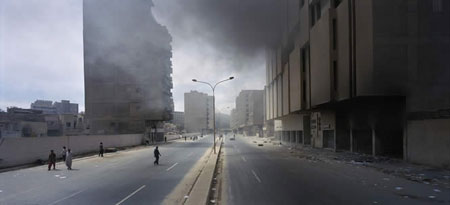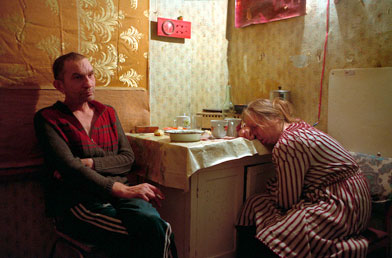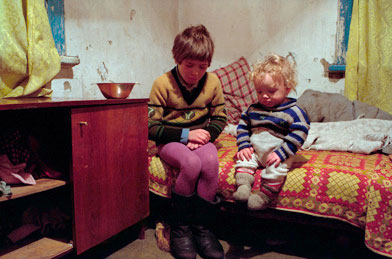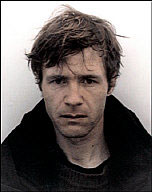 |
→ August 2004 Contents → Column
|
View from the Photo Desk: Luc Delahaye
August 2004
|
 |
|||
|
Luc Delahaye's work spans the world of journalism and art. As a war photographer, he has documented many conflicts around the world. At the same time, he started work on documentary portraiture and then engaged himself in a broader approach to documentary photography. In his latest projects, he took a long trip across Russia, examining the country's economic depression, and a four-month stay in the suburb of Toulouse, France. He now works on documentary photography in the fields of news and history.
A partial bibliography of Delahaye's works include: "Portraits/1" (1996); "Memo" (1997); "L'Autre" (1999); "Winterreise" (2000); "History" (2003) and "Une Ville" (2003). Luc Delahaye recently resigned from Magnum. He agreed to answer a few questions for The Digital Journalist, but asked that the subject of his departure from the most prestigious agency in photojournalism be left out. Q: How do you approach a theme that you are interested in documenting? Is there a process you use to determine what you will focus your energies on? A: I don't think I had subjects in the past. I was working mainly on "situations," ideas of situations, etc. War was one of them. I was also working, at first almost unconsciously, then with a method, on the medium itself and its possibilities and limits. But it's clear that I have a subject now, and it's a basic one: these global events which eventually become history. You always need a subject, even if the subject is just an excuse.  From "Winterreise": A Winter Journey Through Russia, Photo by Luc Delahaye Q: Some of the most powerful work you did in the past was during the war in Bosnia. How did your experience there influence your later work? A: In Bosnia, I had the possibility to work on a long-term basis. It helped me a lot to define what I wanted to do in photography, to define an attitude. Q: Why did you choose to work in the panoramic format with your "History" project, and what cameras do you use for this style of work? A: I'm using a 6x12 cm medium-format. I chose this format just because I like its generous proportions. It's not a real panoramic, as the ratio is 1:2. {Editor's note: Linhof Technorama 612 camera}
 Baghdad, from Luc Delahaye's book, "History" Q: Your work is seen these days mostly in books, galleries and museums. For the "History" project you released a special limited-edition book, available only in an edition of 100, at a price of $1,000 each. Has this way of showing your work been successful for you? A: Yes. Q: Your photographs in the book project "Winterreise" have been described as being both depressing in subject matter and as a masterpiece of photographic reportage. Why did you decide to do this project and how did you go about doing it? A: I wanted to confront myself to something extreme. And I wanted to try a poetic approach on a subject, something different from the dryness of my war pictures.
 From "Winterreise": A Winter Journey Through Russia, Photo by Luc Delahaye  From "Winterreise": A Winter Journey Through Russia, Photo by Luc Delahaye Q: Do you only use film cameras or both film and digital? What do you think of shooting digitally? A: I'm using film and I like digital cameras, too. Q: In the new direction that you are now moving, what do you hope to show in your future photographs that you feel was missing in the past work? A: More of everything ... I'm doing what I've always done, but now it's quite formalized. I hope it allows "more of everything" to surface. A couple of weeks after Luc Delahaye answered these questions, I went to see the photography collection of the Chrysler Museum in Norfolk, Va., on a quiet Sunday afternoon. Among the images on display, from W. Eugene Smith, Larry Burrows and Walker Evans to Richard Avedon, Sally Mann and William Allard, was one by Luc Delahaye. It took up an entire wall of the museum, the print measuring 8 feet wide by 4 feet high. The photo, entitled "Taliban 2001," from the "History" project, commands attention, and not just because of scale: A dead Taliban fighter, shoes removed and his wallet tossed nearby, surrounded by footprints, every detail rendered with amazing clarity. It is like being confronted with a disturbing reality that, for most people, remains far more removed, usually only seen in fleeting images on television or in diminished size, if at all, in the press. I observe as a middle-aged woman accompanied by a teen boy walks past, repelled by her first glance at the photo, ushers the child away to another photo, then returns alone and sits on a bench a few feet in front of the image. She looks intently, then gets up for a closer look, nose almost touching the glass.  Dead Taliban fighter, Afghanistan, from Luc Delahaye's book, "History"
© Roger Richards
|
||||
Back to August 2004 Contents |
|
